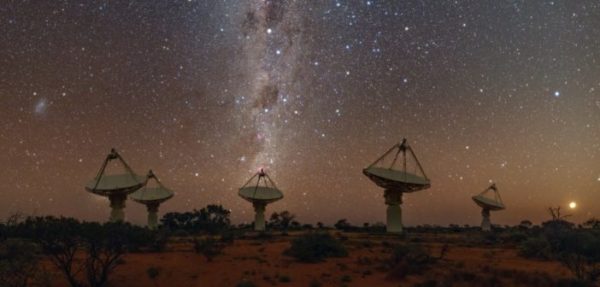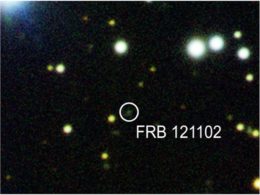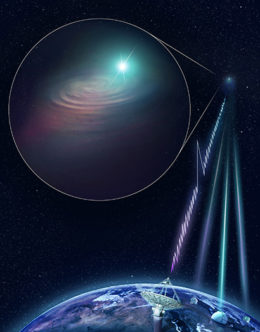New evidence deepens the mystery of fast radio bursts (FRBs), the brief flashes of radio emission stemming from unknown sources beyond our galaxy.

CSIRO / Alex Cherney
Scientists have now discovered faint repeat bursts from one of the brightest FRBs, previously thought to have been a one-off event.
To Repeat or Not to Repeat
It was over a decade ago that scientists noticed the first enigmatic, millisecond-duration burst of radio waves from outside of the Milky Way. Since then, we’ve discovered about 100 FRB sources and even identified the host galaxies for several of them. Nonetheless, we still don’t know what causes FRBs, or even whether they’re all the same type of phenomenon.

Gemini Observatory / AURA / NSF / NRC
FRB properties span a wide range, but one of the biggest distinguishing features has been repetition. While most discovered FRBs have been one-off events — a single bright flash and no evidence of any additional emission from the same region either before or after — around ten FRBs have been found to repeat.
We successfully localized one repeating FRB to a distant low-mass, low-metallicity dwarf galaxy. The two non-repeating bursts that we’ve localized, on the other hand, are associated with very massive host galaxies. Does this distinction mean that repeating and non-repeating bursts make up two different classes of FRBs? Or are FRBs all the same type of source, and the difference in host galaxies is just random variation?
Recently, a team of scientists led by Pravir Kumar (Swinburne University of Technology, Australia) has added one more clue to the puzzle: observations of weak repeat bursts from an FRB thought to be non-repeating.
What Are We Missing?

CSIRO / Andrew Howells
Kumar and collaborators were testing a simple theory: What if FRBs all repeat, but we don’t have the sensitivity to detect the fainter bursts?
In this scenario, supposed one-off FRBs are actually just the most energetic bursts from repeating sources. If we carefully study very sensitive observations of the region around a non-repeating burst, the team reasoned, we might find evidence of other bursts from the same source.
The authors chose FRB 171019 as their target — one of the brightest bursts found in a recent survey conducted with the Australian Square Kilometre Array Pathfinder (ASKAP). Kumar and collaborators used ASKAP itself, as well as the 64-meter Parkes radio telescope and the 110-meter Green Bank Telescope, to conduct follow-up observations of the 10’ x 10’ region FRB 171019 was determined to have originated from.
Faint Flashes Found

Kumar et al. 2019
Though no additional bursts were found in the follow-up ASKAP or Parkes data, two faint bursts were visible in the 820 MHz Green Bank Telescope data, occurring 9 and 20 months after the initial ASKAP burst detection. The inferred distances are consistent with that of FRB 171019, but they are a whopping factor of ~590 fainter than the original burst!
This discovery lends credence to the idea that more seemingly one-off bright FRBs may actually have faint repetitions that we’ve simply missed — and these sources may be found to repeat if we conduct follow-up with more sensitive telescopes. Understanding this brings us one step closer to discovering the nature of these mysterious sources.
Citation
“Faint Repetitions from a Bright Fast Radio Burst Source,” Pravir Kumar et al 2019 ApJL, 887, L30.
This post originally appeared on AAS Nova, which features research highlights from the journals of the American Astronomical Society.
 0
0
Comments
Randy Pfeiffer
February 6, 2020 at 10:11 am
FRB events seem consistent with pulsar signals, except for their lack of regularity. Is it possible that FRB sources are pulsars, in which precession causes ongoing changes in the beam plane, and these changes are more obvious to us because of the great distances involved? In "Pulsars and Precession: An Introduction", F. A. M. Frescura describes the appearance of precession: "As the beam plane precesses, not only will the beam plane oscillate about the reference plane, but the beam will also oscillate within the beam [plane] about some mean direction." Also, in "Radio emission from a pulsar’s magnetic pole revealed by general relativity", Gregory Desvignes (et al) report measurement of pulsar precession in pulsar PSR J1906+0746.
You must be logged in to post a comment.
GH Martin
February 7, 2020 at 4:13 pm
Any possibility that the repeat bursts could actually be faint echos?
You must be logged in to post a comment.
robin_astro
February 8, 2020 at 9:16 am
This does not seem to fit the observations. The slowest known radio pulsar PSR J0250+5854 has a period of 23.5 sec. For us to see a single pulse the precession rate would need to be such that the beam moves out of our line of site in less than this time. At slightly slower precession rates we would expect to also see short bursts of multiple pulses at the pulsar rotation period which as far as I understand are not seen.
You must be logged in to post a comment.
You must be logged in to post a comment.